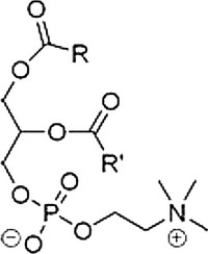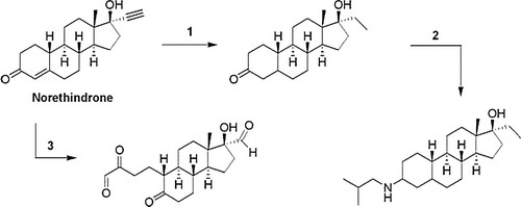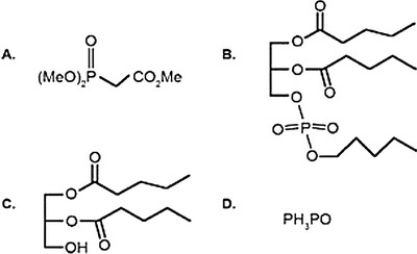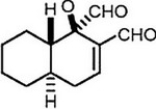Deck 24: Lipids
Question
Question
Question
Question
Question
Question
Question

Unlock Deck
Sign up to unlock the cards in this deck!
Unlock Deck
Unlock Deck
1/7
Play
Full screen (f)
Deck 24: Lipids
1
All except one of the statements below are true about the molecule given. Which statement is not correct? 
A) This molecule is a phospholipid and belongs to the general category of lecithins.
B) This molecule is a phospholipid and is generally found in fruits, vegetables, fish, liver, and dairy products.
C) This molecule contains two fatty acids and has at least one stereogenic center.
D) This molecule is a phospholipid that composes the main fabric of the insoluble barrier that protects the cell.

A) This molecule is a phospholipid and belongs to the general category of lecithins.
B) This molecule is a phospholipid and is generally found in fruits, vegetables, fish, liver, and dairy products.
C) This molecule contains two fatty acids and has at least one stereogenic center.
D) This molecule is a phospholipid that composes the main fabric of the insoluble barrier that protects the cell.
This molecule is a phospholipid and is generally found in fruits, vegetables, fish, liver, and dairy products.
2
Norethindrone is a synthetic steroid that is better than progesterone in suppressing ovulation. What reagents (1-3) are required to convert norethindrone to the derivatives shown below? 
A) (1) H2, Pd-C; (2) (CH3)2CHCH2NH2, NaBH3CN; (3) a. O3, b. Zn, DMS
B) (1) a. LiAlH4, b. H2O; (2) (CH3)2CHCH2NH2, mild acid; (3) a. OsO4, b. NaHSO3
C) (1) a. LiAlH4, b. H2O; (2) (CH3)2CHCH2NH2, NaBH3CN; (3) a. OsO4, b. NaHSO3
D) (1) H2, Pd-C; (2) (CH3)2CHCH2NH2, mild acid; (3) a. O3, b. Zn, DMS

A) (1) H2, Pd-C; (2) (CH3)2CHCH2NH2, NaBH3CN; (3) a. O3, b. Zn, DMS
B) (1) a. LiAlH4, b. H2O; (2) (CH3)2CHCH2NH2, mild acid; (3) a. OsO4, b. NaHSO3
C) (1) a. LiAlH4, b. H2O; (2) (CH3)2CHCH2NH2, NaBH3CN; (3) a. OsO4, b. NaHSO3
D) (1) H2, Pd-C; (2) (CH3)2CHCH2NH2, mild acid; (3) a. O3, b. Zn, DMS
(1) H2, Pd-C; (2) (CH3)2CHCH2NH2, NaBH3CN; (3) a. O3, b. Zn, DMS
3
Which of the following is a fat soluble vitamin?
A) All of these choices are correct
B) Vitamin K
C) Vitamin A
D) Vitamin D3
A) All of these choices are correct
B) Vitamin K
C) Vitamin A
D) Vitamin D3
All of these choices are correct
4
The stereoselective introduction of the C15 OH group on the w side chain of prostaglandins has presented a challenge for synthetic chemists. Recently, Mulzer and co-workers demonstrated a new route in which the w side chain is synthesized independently and then attached to the bicyclic counterpart. What is the appropriate sequence of reagents for the following synthesis? 
A) (1) PBr3; (2) Grubbs' catalyst, Reagent X; (3) KOC(CH3)3
B) (1) TsCl, pyridine; (2) Grubbs' catalyst, Reagent X; (3) KOC(CH3)3
C) (1) PBr3; (2) Ph3P=CH2; (3) Grubbs' catalyst, Reagent X
D) (1) PCC; (2) Ph3P=CH2; (3) Grubbs' catalyst, Reagent X

A) (1) PBr3; (2) Grubbs' catalyst, Reagent X; (3) KOC(CH3)3
B) (1) TsCl, pyridine; (2) Grubbs' catalyst, Reagent X; (3) KOC(CH3)3
C) (1) PBr3; (2) Ph3P=CH2; (3) Grubbs' catalyst, Reagent X
D) (1) PCC; (2) Ph3P=CH2; (3) Grubbs' catalyst, Reagent X

Unlock Deck
Unlock for access to all 7 flashcards in this deck.
Unlock Deck
k this deck
5
Which of the following is a phospholipid? 
A) A
B) B
C) C
D) D

A) A
B) B
C) C
D) D

Unlock Deck
Unlock for access to all 7 flashcards in this deck.
Unlock Deck
k this deck
6
Eicosanoids are derived from what compound?
A) Cyclohexane
B) Triacylglycerols
C) Arachidonic acid
D) Cholesterol
A) Cyclohexane
B) Triacylglycerols
C) Arachidonic acid
D) Cholesterol

Unlock Deck
Unlock for access to all 7 flashcards in this deck.
Unlock Deck
k this deck
7
Evaluate the following statement: The terpene structure shown is a hydrolysable lipid. 
A) True, because it contains an alcohol functional group.
B) False, because there is too much steric repulsion from the alcohol and aldehyde moieties.
C) True, because there are three polar groups and only 12 total carbon atoms.
D) False, because alcohol and aldehyde moieties are not hydrolysable.

A) True, because it contains an alcohol functional group.
B) False, because there is too much steric repulsion from the alcohol and aldehyde moieties.
C) True, because there are three polar groups and only 12 total carbon atoms.
D) False, because alcohol and aldehyde moieties are not hydrolysable.

Unlock Deck
Unlock for access to all 7 flashcards in this deck.
Unlock Deck
k this deck



